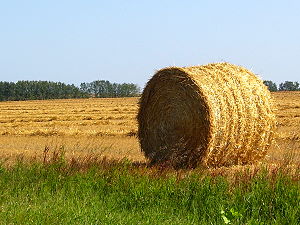 Northwest Region Crop Report Prepared by: Manitoba Agriculture
Northwest Region Crop Report Prepared by: Manitoba Agriculture
October 16, 2017 |
Northwest Region
Nice fall weather continued throughout the Northwest Region and this resulted in good harvest progress over the last week. The spring wheat harvest is basically complete, and most canola is harvested although some of the later seeded canola remains. A few acres of flax and most of the soybeans are still standing in the Roblin area. The hemp harvest is underway. Most of the fall field work is complete and many fields are ready for spring. Some anhydrous ammonia has been applied as harvest and field conditions allow. Weeds and volunteers are actively growing as minimal fall weed control has taken place at this point.
The red spring wheat harvest is generally complete in the region. The average yield for hard red spring wheat is 75 to 85 bu/acre with 90 to 95% of the crop grading #1, and the remainder grading #2. There are some reports of low protein levels on wheat around the Dauphin area.
Canola harvest is nearing completion, approximately 95% of the acres have been combined. Those acres remaining are on fields that were seeded later in the spring. Canola yields averaged 50 to 60 bu/acre. The quality of canola harvested is standard for the region with 98% #1 and the balance #2.
Field pea harvest operations are complete, and soybean and flax harvest is ongoing. Field peas averaged 65 to 75 bu/acre and graded #1 around Swan River and #2 in the Roblin area. Soybeans are averaging 30 to 50 bu/acre, with 95% of the crop grading #2. There are still some beans out in the field and grain corn remains standing.
The 2017 growing season was a variable one in the Northwest Region with regards to precipitation. Spring conditions were wet with crops stressed from excess moisture and then conditions changed to dry for the remainder of the season. Frost along with wet conditions in the spring resulted in two distinct plantings of canola with better yields on the earlier seeded canola. These wet spring conditions delayed emergence on some crops as well. As the season progressed, the region received very little precipitation and crops were under drought stress for the remainder of the growing season.
These dry conditions along with high temperatures caused some pod abortion during flowering on canola however yields and quality did not seem to be affected a significant amount. The dry weather conditions helped to reduce disease pressure. There was some flea beetle damage early in the season along with low levels of sclerotinia and alternaria in canola. Wheat midge populations were high in the Roblin area but did not appear to cause yield losses or reduce crop quality. Producers were able to limit the impact of disease and insect pressure due to appropriate application of fungicides and insecticides to susceptible crops at the most beneficial stage.
For the most part, this year has resulted in average yields for tame hay and greenfeed with good quality. Corn silage yields have been average to above average with exceptional quality due to many harvesters available in a timely manner. Wild hay production was higher than any year reported since 2011. Quality of wild hay will be variable due to harvest timing, species present and % residue in the bale. Forage yields around Roblin and corn silage yields around Swan River were lower as a result of drier conditions.
Feed supplies are adequate. Hay feed test results are showing variable quality. Pasture conditions are variable and sites with less management are suffering from overgrazing.
Availability of livestock water in the region is rated at 95 to 100% adequate. Additional moisture will be required to replenish some dugouts which are rated at 50 to 60% full. There have been reports of isolated cases of dugouts drying up. Poor water quality is also concern with lower water levels.
